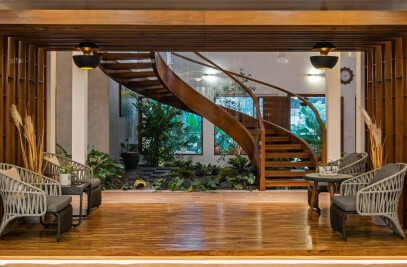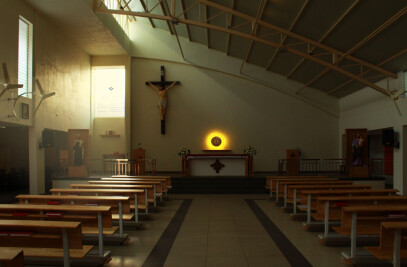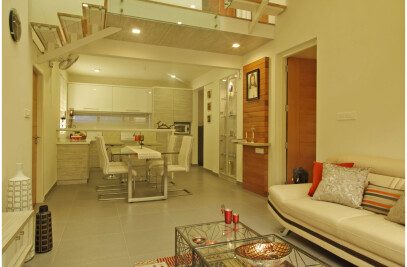A metamorphic departure in search of contemporary vocabulary, the Salafi Masjid is a soulful realization of tranquillity within the walls. Set amidst a busy regular street in Aluva, the mosque univocally transcends itself as a ‘pause’ and a ‘journey’ to ataraxy. Sprawling across 8.5 cents of land, the mosque embraces the thought-provoking Islamic philosophy from the holy Quran: “He created the skies with the light, without pillars you see it” – throughout the design. Thus, the light becomes the soul of the mosque, and the induced transparency becomes the heart of its design. The 3230 sq. ft structure spread out in two floors emerges itself as a landmark for the locals, pilgrims and wayfarers.

Site and Context
Situated in a mixed-use zone abutting the state highway in Chunangamvely in Aluva, the location and its context provide the project an identity to connect with different levels of the city. With porous street edge profile delineated by tree canopies, the street frontage is characterized by low rise buildings. The site at street level, the adjoining plot at a higher level and the context without any distinct architectural character – harmoniously favours in with our liberty to express and experiment with materials, form and spatial planning.


Design Programme
The Design programme derives its idea of spaces and their functions from the ideals of the Salafi community to develop a secular and communal space responding effectively to its context. The design aims to connect the structure to the street, along with creating a peaceful environment for religious activities.
Zoning
With the site characterized by a busy street with commercial activities, the building is zoned into two levels: the lower level with congregational space and the upper level with sacred space. The overall built mass with self-contained religious space is designed to engage with its context without losing its serenity. Thus, the commercial block is designed to actively respond to its adjoining street.
Form Development
The two levels are developed into two distinct volumes based on their functions. Placed on top of the commercial block, the religious block is slightly rotated orienting the prayer hall towards the west – the Qibla (the direction of Kaaba). As the design progressed, the rectangular volume is chamfered along all the corners to form a curved built envelop emphasizing the continuity of the form in the exterior and obtaining a more defined religious interior space with improved functionality and spatial quality. The rectangular form with curved corners is complimented by the domed roof on top and balanced by the tall, circular minaret in the northside.
Commercial Block
The ground floor is proposed with maximum utilization of the permissible buildable area of the site. With minimum setbacks on all the sides, the front yard lined with trees acts as a buffer zone between the building and the street.

Religious Block
Solely designed for religious activities, the upper block is divided into separate prayer halls and ablutions spaces for men and women along with a classroom. The octagonal prayer hall in the centre is oriented towards the curved corner facing the west forming a symbolic mihrab. Philosophies, symbolism and design
Philosophies, symbolism and design
The physical structure and the spaces created within a sacred enclosure plays a vital role in creating awe, a sense of satisfaction and serenity, which thoroughly influences the behavioural aspect of the user. The Salafi community believes in the individualistic approach towards the almighty with spaces being the functionally differentiated analogues to these philosophies. Heeding to the community beliefs, a conscious decision was made to provide segregated prayer spaces accessed through separate stairways for men and women.
Accessed directly from the street level, the staircases leading into prayer hall adds in character to the structure. The narrow passage forming the stairs lined with plain walls on both sides is derived from the circumambulatory path of the ancient Indian religious believes. The staircase is a pure symbolization of the search for light (enlightenment) during dark times (the journey through the narrow passage), culminating in the prayer hall. It is an attempt to create a spiritualistic procession with an element of surprise.
 Building Envelope
Building Envelope
The monotony of the building envelope is broken down with the introduction of voids, openings, varying textures and colours. Apart from the aesthetic appeal, the jaali given around the built envelope is designed to provide natural ventilation without compromising the privacy. The increased building porosity also ensures continuous airflow in and out of the structure lowering the indoor temperature and cooling down the interiors considerably.
Interiors
The interiors are designed to be simple, light, spacious and welcoming. The larger prayer hall for men placed in the centre shares one of its walls with the smaller prayer hall for women on the southern side. The play of light with the patterns created by the jaalis and skylights brings in dynamics to the interiors. The lighting with a monotonous interior colour palette forms the sole element dictating the spatial quality to develop the space into more than mere walls and openings. With the varied lighting, the calmness offered by the light colours interiors, the design aims to transcend the space into an intermediate realm together with establishing a dialogue between its users.


Reinterpretation of the traditional elements
Designed to embrace the traditional and contemporary, the mosque is a beautiful amalgam of both styles. The conventional elements like domes and minarets are introduced into the design with a modern twist. Designed with ribbed vaults, two half domes are erected with a clerestory in between them. The single dome adds more volume to the central prayer space. Located on the northern side, the single minaret is designed against the rectangular volume, visually balancing it. Unlike the conventional ones, the minaret is proposed to have a chamfered top with tiny circular voids along the walls for ample lighting and ventilation.


In search of light.
The two-floored structure is a beautiful composition of religious symbolism, functional modernity, user sensitive spatial organization and context-specific design embracing religious ideologies and principles from inception to execution. The mosque is a carefully crafted attempt to discover and translate the quintessence of these spiritual philosophies into the architectural vocabulary through design.















































